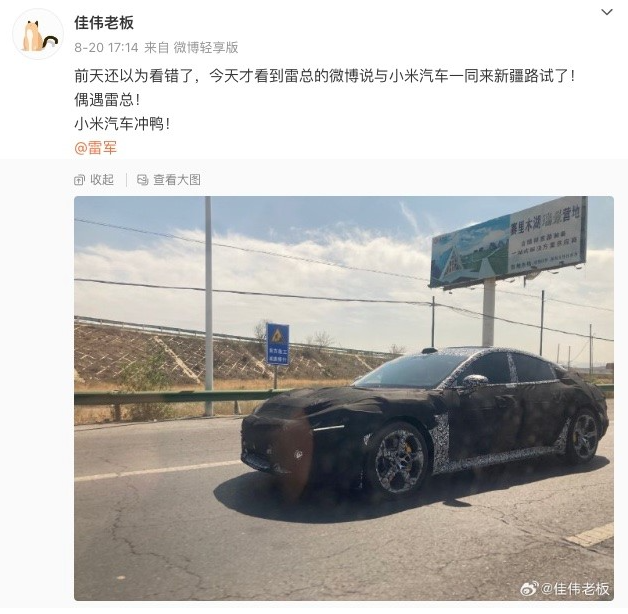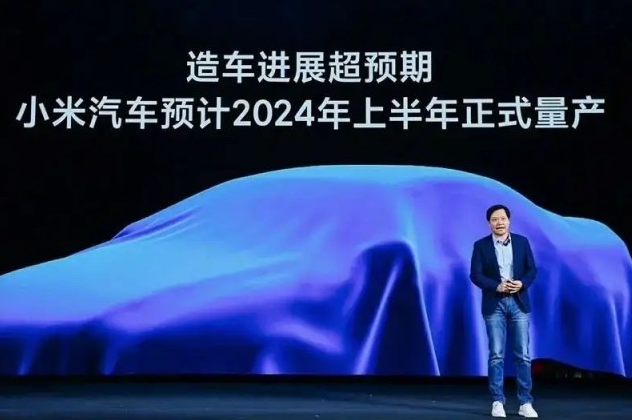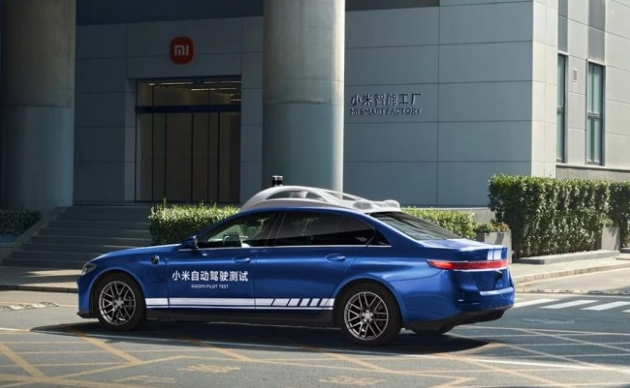 Technology peripherals
Technology peripherals
 It Industry
It Industry
 Xiaomi Motors' first electric sedan revealed: design and technical highlights
Xiaomi Motors' first electric sedan revealed: design and technical highlights
Xiaomi Motors' first electric sedan revealed: design and technical highlights
News on October 18th, news that Xiaomi Auto is about to debut has spread frequently recently, attracting widespread attention. Tianfeng International Securities analyst Ming-Chi Kuo recently published an article revealing that Xiaomi Motors’ first model is planned to be released in 2024, with sales expected to reach 50,000 to 60,000 units. Its main features are autonomous driving, software ecosystem, 800V fast charging and power configuration. The price is expected to be less than 300,000 yuan. If the selling price can be close to 250,000 yuan, then the sales volume may be increased.
Xiaomi officially announced its entry into the automotive industry in March 2021, planning to invest US$10 billion in the next ten years. At that time, due to Xiaomi's cost-effective label in the mobile phone market, people had high hopes for Xiaomi's ability to launch cost-effective cars that young people could afford. However, more than two years have passed, and Xiaomi's automobile manufacturing qualifications have not yet been finalized. Although it has entered the trial production stage and has repeatedly emphasized its mass production target in the first half of 2024, it has not yet been finalized.

At the same time, since 2023, multiple rounds of price wars have led many car companies to lower the prices of flagship models to the range of 200,000 to 300,000 yuan. In addition, Tesla’s absolute advantage in this price range makes it questionable whether Xiaomi Motors will still be competitive when it enters the market.
However, the details of the first model have been initially determined. According to currently exposed spy photos, Xiaomi’s first car is a fastback electric sedan with a smooth appearance and a closed front design. The side of the body is equipped with hidden door handles, and the roof lines are smooth and sporty. The rear of the car will use a through-type taillight design, and the rear window may adopt a hatchback design.

In terms of vehicle technology, Xiaomi Automobile will use Qualcomm Snapdragon 8295 chip and be equipped with a self-developed in-vehicle operating system. In addition, Xiaomi cars will also be equipped with lidar to support advanced driving assistance functions. According to previous public information, Xiaomi Auto's autonomous driving system uses a self-developed algorithm and is currently in the testing phase. It has functions such as automatic entry and exit of ramps, active lane changes for overtaking, and automatic island detours on urban roads.
In addition, there is news that Xiaomi Automobile will be equipped with CATL Kirin battery with a capacity of 101kWh and a voltage of 726.7V, indicating that Xiaomi Automobile will use an 800V battery platform. However, there are also reports that low-end models may use a 400V battery platform, while only high-end models will use an 800V battery platform.

Xiaomi Motors also plans to launch extended-range models and is developing multi-generation platforms. The first-generation platform is planned to be launched next year, while the second-generation platform is planned to be released in 2025. The extended-range model is expected to be unveiled together with the second-generation platform.
In addition, the production of Xiaomi cars is ready. The first phase of Xiaomi Motors' Yizhuang factory in Beijing has been basically completed, with a planned annual production capacity of 150,000 vehicles. The second phase of the project is planned to start in 2024 and be completed in 2025. According to reports, the first phase of the factory is currently in the trial production stage and produces about 50 prototypes per week. The factory is also recruiting workshop workers on a large scale and plans to hire about 100 workers, providing an average salary of 6,000 to 7,000 yuan. They work 8 hours a week and have weekends off, so they can join at any time. Once approved by the Ministry of Industry and Information Technology, Xiaomi's factory will officially mass-produce before the end of the year, and the delivery target in the first half of 2024 may be achieved as scheduled.


However, Xiaomi Motors entered the market relatively late, and competition in the domestic new energy vehicle market has become fierce. At present, the new energy vehicle market has stabilized, and the top few car companies have monopolized most of the market share. For Xiaomi Auto to successfully enter the market, it may need to launch applications or new technologies with huge appeal, or offer competitive prices. In addition, Xiaomi can leverage the advantages of its ecosystem, including operating systems, applications, hardware such as mobile phones and IoT, as well as sales channels in overseas markets. Despite fierce competition, Xiaomi Auto still has a chance to stand out in the market.
The above is the detailed content of Xiaomi Motors' first electric sedan revealed: design and technical highlights. For more information, please follow other related articles on the PHP Chinese website!

Hot AI Tools

Undresser.AI Undress
AI-powered app for creating realistic nude photos

AI Clothes Remover
Online AI tool for removing clothes from photos.

Undress AI Tool
Undress images for free

Clothoff.io
AI clothes remover

Video Face Swap
Swap faces in any video effortlessly with our completely free AI face swap tool!

Hot Article

Hot Tools

Notepad++7.3.1
Easy-to-use and free code editor

SublimeText3 Chinese version
Chinese version, very easy to use

Zend Studio 13.0.1
Powerful PHP integrated development environment

Dreamweaver CS6
Visual web development tools

SublimeText3 Mac version
God-level code editing software (SublimeText3)

Hot Topics
 1666
1666
 14
14
 1426
1426
 52
52
 1328
1328
 25
25
 1273
1273
 29
29
 1253
1253
 24
24
 CNCF Arm64 Pilot: Impact and Insights
Apr 15, 2025 am 08:27 AM
CNCF Arm64 Pilot: Impact and Insights
Apr 15, 2025 am 08:27 AM
This pilot program, a collaboration between the CNCF (Cloud Native Computing Foundation), Ampere Computing, Equinix Metal, and Actuated, streamlines arm64 CI/CD for CNCF GitHub projects. The initiative addresses security concerns and performance lim
 Serverless Image Processing Pipeline with AWS ECS and Lambda
Apr 18, 2025 am 08:28 AM
Serverless Image Processing Pipeline with AWS ECS and Lambda
Apr 18, 2025 am 08:28 AM
This tutorial guides you through building a serverless image processing pipeline using AWS services. We'll create a Next.js frontend deployed on an ECS Fargate cluster, interacting with an API Gateway, Lambda functions, S3 buckets, and DynamoDB. Th
 Top 21 Developer Newsletters to Subscribe To in 2025
Apr 24, 2025 am 08:28 AM
Top 21 Developer Newsletters to Subscribe To in 2025
Apr 24, 2025 am 08:28 AM
Stay informed about the latest tech trends with these top developer newsletters! This curated list offers something for everyone, from AI enthusiasts to seasoned backend and frontend developers. Choose your favorites and save time searching for rel
 CNCF Triggers a Platform Parity Breakthrough for Arm64 and x86
May 11, 2025 am 08:27 AM
CNCF Triggers a Platform Parity Breakthrough for Arm64 and x86
May 11, 2025 am 08:27 AM
CI/CD puzzles and solutions for open source software in Arm64 architecture Deploying open source software on Arm64 architecture requires a powerful CI/CD environment. However, there is a difference between the support levels of Arm64 and traditional x86 processor architectures, which are often at a disadvantage. Infrastructure components developers for multiple architectures have certain expectations for their work environment: Consistency: The tools and methods used across platforms are consistent, avoiding the need to change the development process due to the adoption of less popular platforms. Performance: The platform and support mechanism have good performance to ensure that deployment scenarios are not affected by insufficient speed when supporting multiple platforms. Test coverage: Efficiency, compliance and
 Benefits of Custom Telecommunication Software
May 11, 2025 am 08:28 AM
Benefits of Custom Telecommunication Software
May 11, 2025 am 08:28 AM
Customized telecom software development is undoubtedly a considerable investment. However, in the long run, you may realize that such a project may be more cost-effective because it can increase your productivity like any ready-made solution on the market. Understand the most important advantages of building a customized telecommunications system. Get the exact features you need There are two potential problems with the off-the-shelf telecom software you can buy. Some lack useful features that can significantly improve your productivity. Sometimes you can enhance them with some external integration, but that isn't always enough to make them great. Other software has too many functions and is too complicated to use. You probably won't use some of these (never!). A large number of features usually adds to the price. Based on your needs



